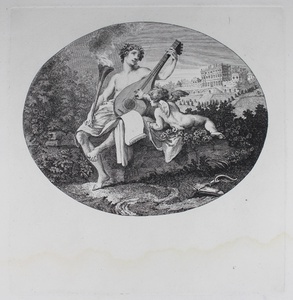| Method | Copper engraving |
| Artist | William Hogarth |
| Published | [J & J Boydell, c.1802] |
| Dimensions | Image 150 x 190 mm, Plate 220 x 215 mm, Sheet 280 x 470 mm |
| Notes |
An oval vignette of Cupid and Hymen, set in an arcadian landscape with Cliveden House in the background, engraved by Hogarth and used for three separate purposes. Initially, it acted as a ticket for a performance of Alfred the Great, King of England, staged at Cliveden to celebrate the birthday of Princess Augusta. It was subsequently reused as an alternative subscription ticket for Hogarth's Election series, before finally being used as as an entry ticket for the raffling of Hogarth's painting of Sigismunda. After the plate was purchased from Jane Hogarth, the Boydells erased all inscriptions and reissued it, as here, as a purely decorative plate. William Hogarth (1697 - 1764) was born in London, the son of an unsuccessful schoolmaster and writer from Westmoreland. After apprenticeship to a goldsmith, he began to produce his own engraved designs in about 1710. He later took up oil painting, starting with small portrait groups called conversation pieces. He went on to create a series of paintings satirising contemporary customs, but based on earlier Italian prints, of which the first was The Harlot's Progress (1731), and perhaps the most famous The Rake's Progress. His engravings were so plagiarised that he lobbied for the Copyright Act of 1735, commonly referred to as 'Hogarth's Act,' as a protection for writers and artists. During the 1730s Hogarth also developed into an original painter of life-sized portraits, and created the first of several history paintings in the grand manner. Paulson 151 Condition: Strong clean impression. Large waterstain to bottom of sheet and plate, not affecting image. |
| Framing | unmounted |
| Price | £100.00 |
| Stock ID | 50687 |

